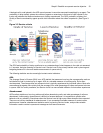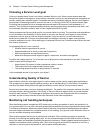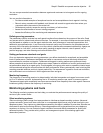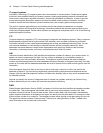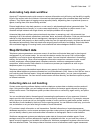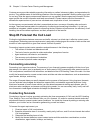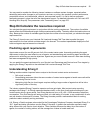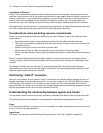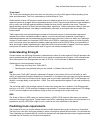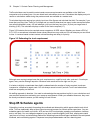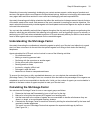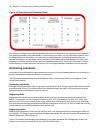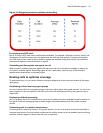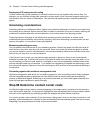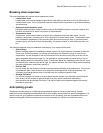Step #4 Calculate the resources required 31
Trunk Load
The Trunk Load includes the time from when a trunk picks up a call until the agent finishes speaking to the
caller and disconnects. The Trunk Load does not include Wrap Up Time.
Callers expect to have a 95 percent or better chance of obtaining a free trunk in to your contact center, and
expect to connect to an agent within a reasonable amount of time. There must be sufficient trunks available to
pick up calls, and sufficient agents available to handle the level of traffic carried by the trunks. The more
agents handling a given Call Load, the less delay callers’ experience. Callers experience a delay if there are
insufficient agents available. If the delay is considerable, calls back up and some calls do not reach the
contact center.
Traffic engineering involves estimating the number of trunks and amount of communications equipment
needed to service an anticipated number of callers. It revolves around basic questions concerning the
relationships between service parameters and trunk and agent resources. How much traffic can a particular
number of trunks handle for a particular GOS? What is the GOS for a particular number of trunks and traffic
level? How many trunks are required to handle a particular traffic level and GOS? What is the probability of
delay and length of delay experienced for a particular traffic level and number of agents? How many agents
are required to handle a particular traffic level for a given set of delay characteristics?
Understanding Erlang B
Contact centers use the Erlang B equation to estimate the number of trunks required. Erlang B assumes calls
are not queued and that callers who receive a busy signal do not attempt to call again. It can underestimate
the trunks required. One Erlang equals one hour or 60 x 60 = 3,600 seconds of telephone conversation.
Predicting your trunk requirement involves
• Determining your Busy Hour Traffic (BHT)
• Deciding how many blocked calls you can tolerate, or Grade of Service (GOS)
BHT
The Busy Hour Traffic (BHT) statistic, measured in Erlangs, is the number of hours of call traffic (or trunk
traffic) you experience during the busiest hour of operation. It is important that your busy hour figure represent
the busiest Call Load your trunks will ever receive, and not just today’s peak traffic. BHT is the (average call
duration + average delay) x calls per hour ÷ 3600. This value represents the highest Trunk Load (occupancy)
in hours.
The call center traffic is the average number of trunks busy during the hour in question. One Erlang equals
one hour, or 60 x 60 = 3,600 seconds of telephone conversation. If a contact center experiences 6.12 erlangs
(or 6.12 hours of telephone conversation) during an hour, an average of six trunks were busy.
GOS
The Grade of Service (GOS) value is a decimal fraction. A GOS of P.02 means a caller has a two percent
chance of receiving a busy signal. Contact centers use GOS in calculating the number of trunks required. It is
important to specify a GOS that is right for you in order for the trunk calculation to be realistic.
Predicting trunk requirements
The number of trunks you require reflects the level of traffic expected during your busiest hour of operation.
The busy hour is the hour during the workday in which a trunk group carries the most traffic. You calculate the
Trunk Load after you forecast the Call Load for the busiest hour and determine the number of agents required
to handle the Call Load for your Service Level objective.



